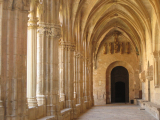Santes Creus: The Cistercian Jewel
Be sure not to miss: the royal tombs of Per el Gran, Jaume II and Admiral Roger de Llúria; the Cistercian and Gothic stained glass windows, and a Baroque altarpiece by Josep Tramulles. Take a look at the Chapter House, the Great Monks' Dormitory and the Cloister, with an elegant sculpted decoration attributed to Reinard des Fonoll. And don't forget to see the stage and audiovisual montage, El mundo del Cister (The Cistercian World).
The outer enclosure of Santes Creus, accessed through the Portal de l'Assumpta, a baroque work with sgraffito, presided over by the fountain dedicated to Sant Bernat Calbó and the Palau de l'Abat, headquarters of the Town Council. In addition to the Monastery, there is a wine cellar by Cèsar Martinell at the entrance to Santes Creus, past the stone bridge and the beautiful Gothic cross. On the banks of the Gaià, you can find the magnificent Alameda de Santes Creus (PEIN), a well-preserved riverside forest, ideal for going for a walk.
The monastery
Santes Creus is one of the 3 largest and best preserved Cistercian monastic complexes that can be visited today. Of these 3, Santes Creus is the one that most faithfully reproduces the Bernardine construction plan. Founded in 1150 and established in Santes Creus from 1160, it went through several glorious stages until 1835 with the final expulsion of the monks. It is currently the only monastery in la Ruta del Cister (Cistercian Route) that does not have monastic life, and allows visitors to enjoy each of the corners of this splendid monastery,
whose stones maintain the most vivid memory of its history. The guides can explain the history and the various legends related to the Monastery.
The royal tombs
Pere el Gran's tomb consists of a large container of red porphyry, brought from the East. It resembles a bathtub, at the foot of which are two lions of probably Mesopotamian origin. At ground level, is the tomb of Roger de Llúria, who asked to be buried at the feet of his lord. Next to it you will find the tomb of Jaume II, the Just, and his wife, Blanca de Anjou, with excellent sculptural details of exquisite beauty.
The monks' dormitory
The architectural and acoustic features of the monks' former dormitory have turned this area into an unbeatable setting for various acts and concerts.
The Royal Palace
Built under the patronage of Per el Gran and Jaume II, it was used as a royal residence for monarchical visits. At the entrance, we find an artesian well that supplied water to the royal family in times of siege. The beam structure and original paintings of the palace are of great artistic value.
The chapiters of the large cloister
Unlike the other two monasteries, which have chapiters decorated with floral motifs, those of the large cloister at Santes Creus have animal and human figures, some of great beauty, attributed to the sculptor Reinard des Fonoll.
Notícies relacionades































 Entorn Web · Àrea de Coneixement i Qualitat
Entorn Web · Àrea de Coneixement i Qualitat Oficina de Gestió de Turisme de l’Alt Camp
Oficina de Gestió de Turisme de l’Alt Camp






 turismealtcamp
turismealtcamp turismealtcamp
turismealtcamp turismealtcamp
turismealtcamp